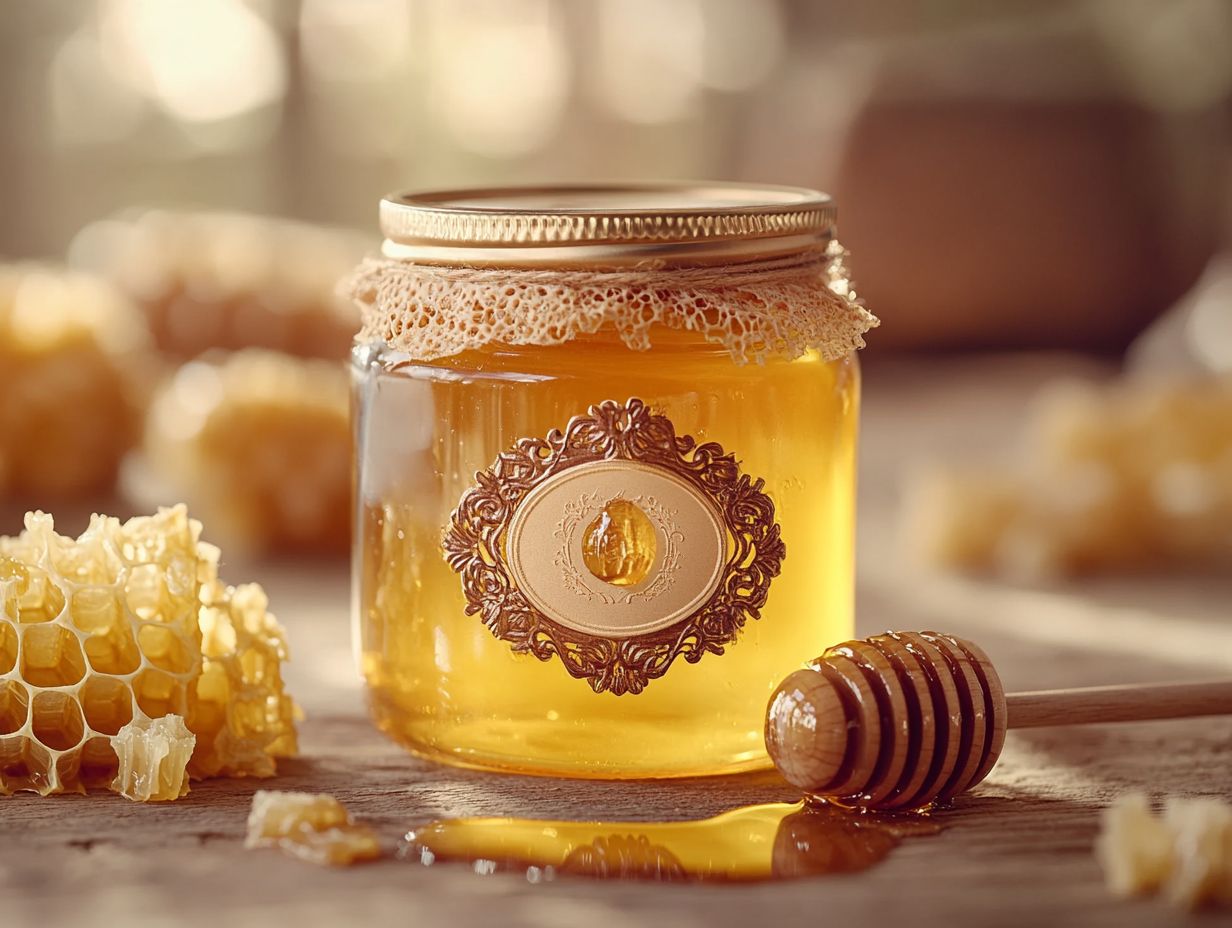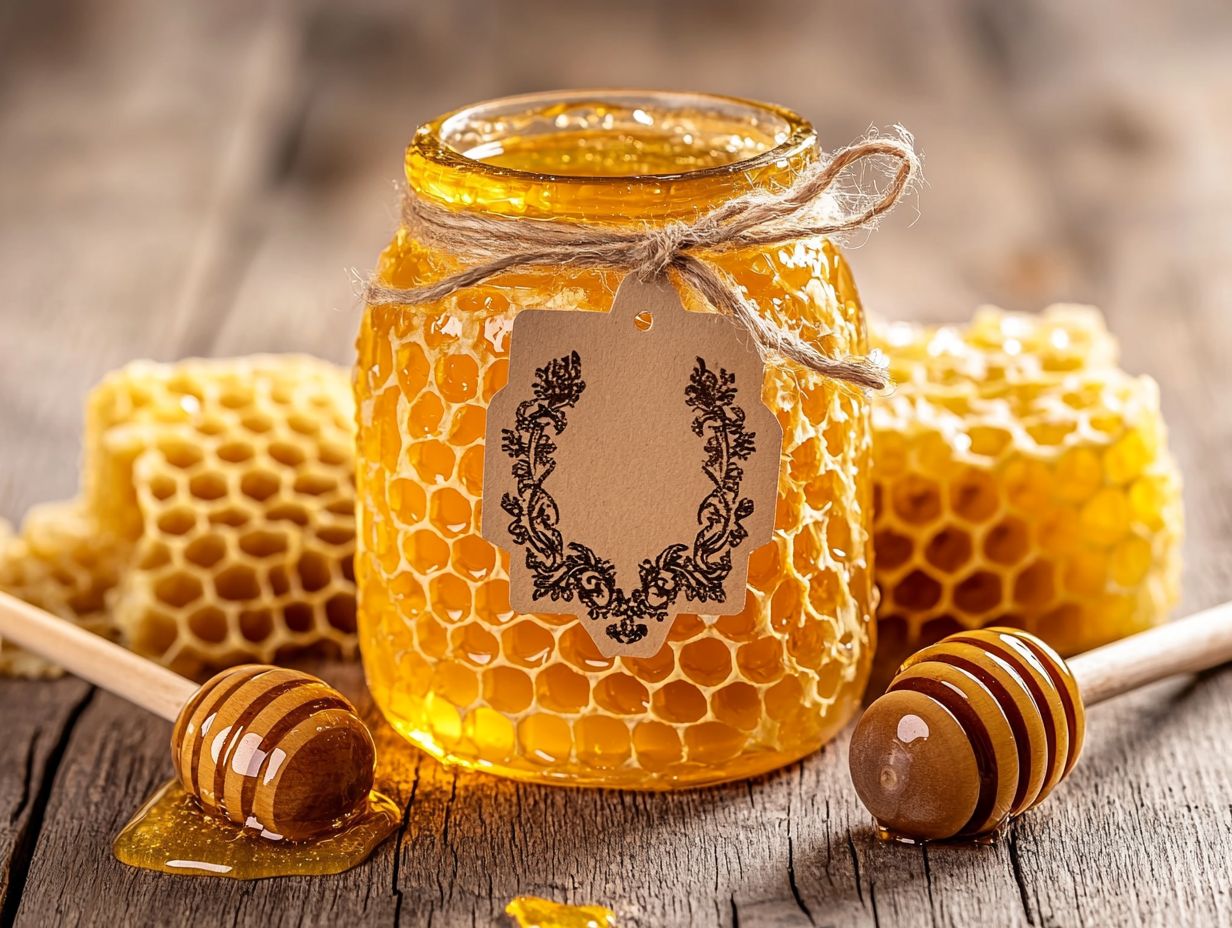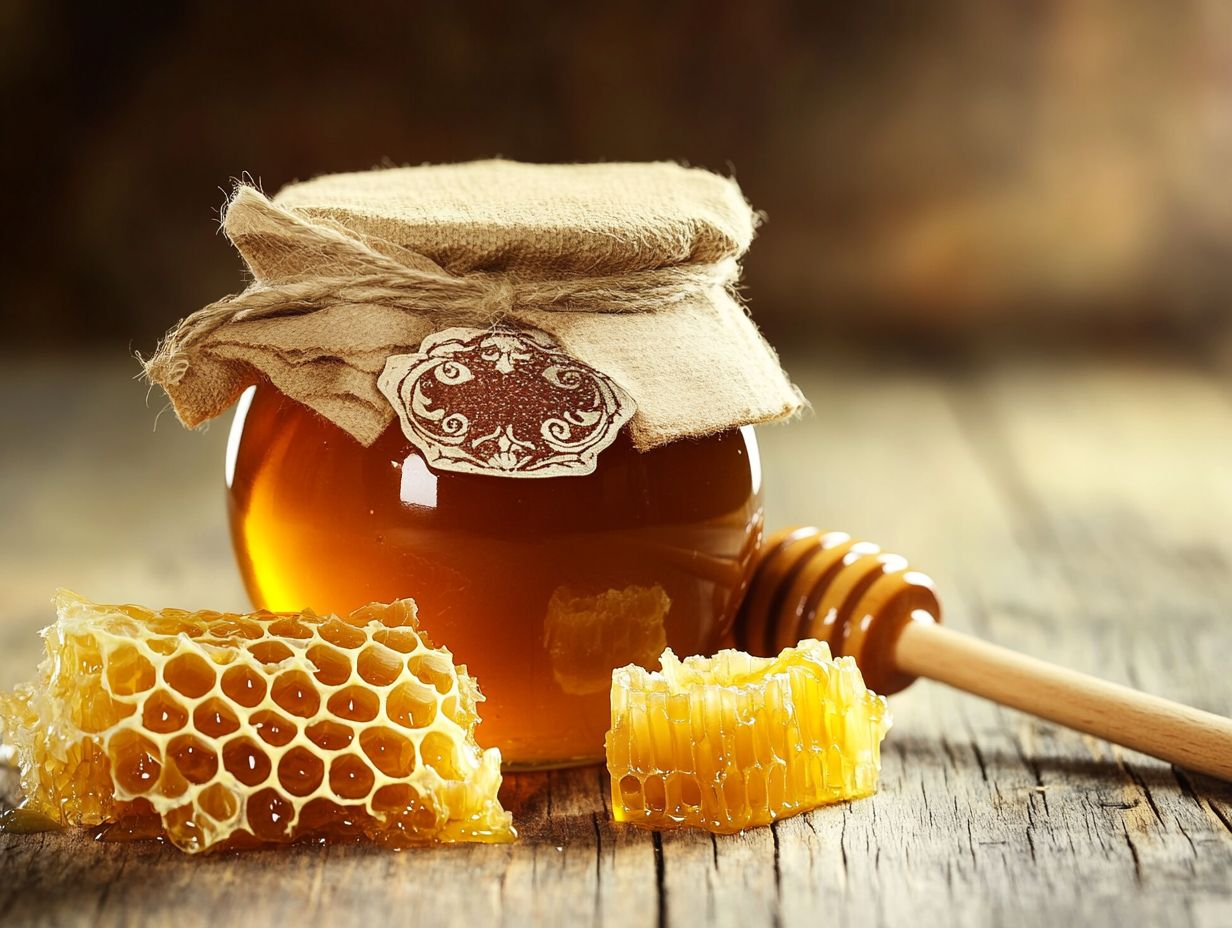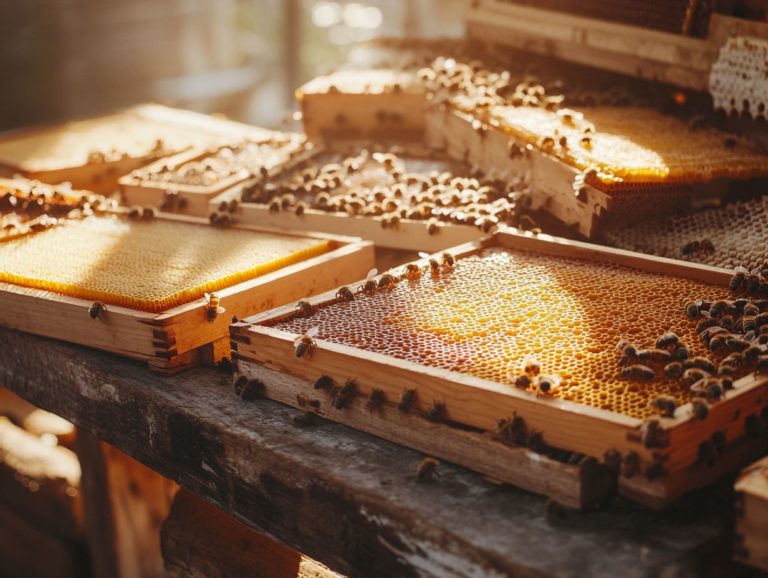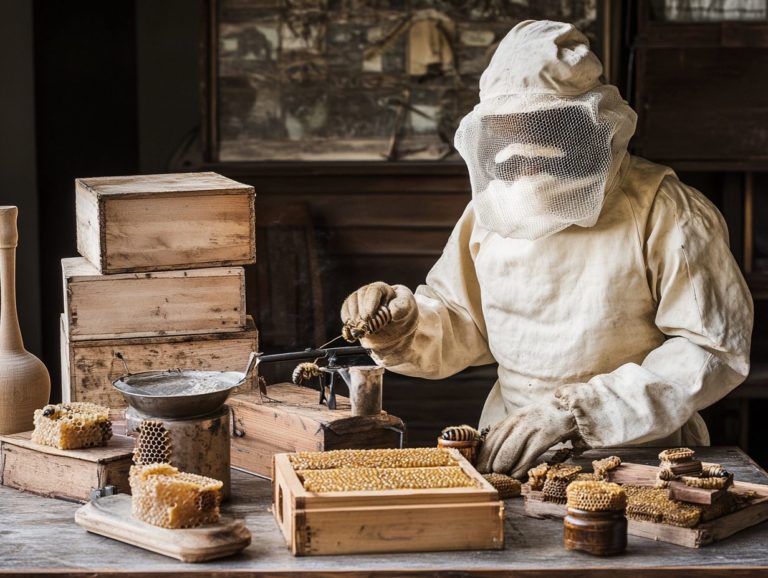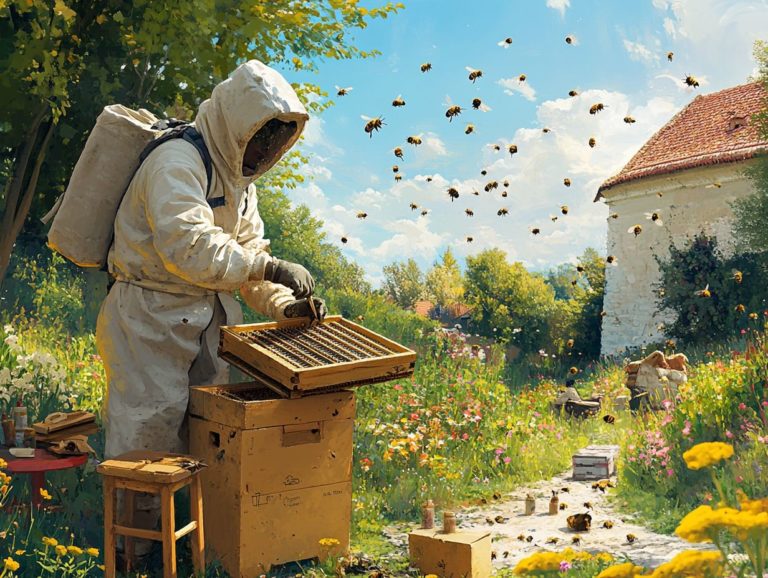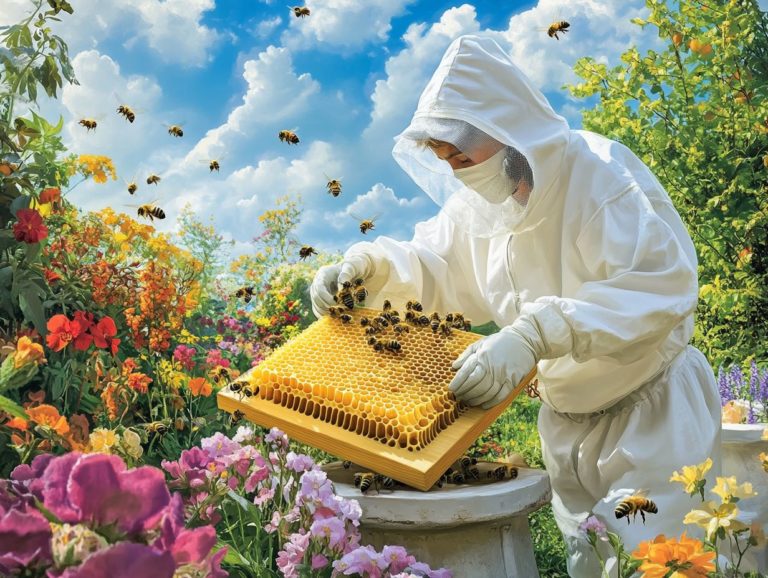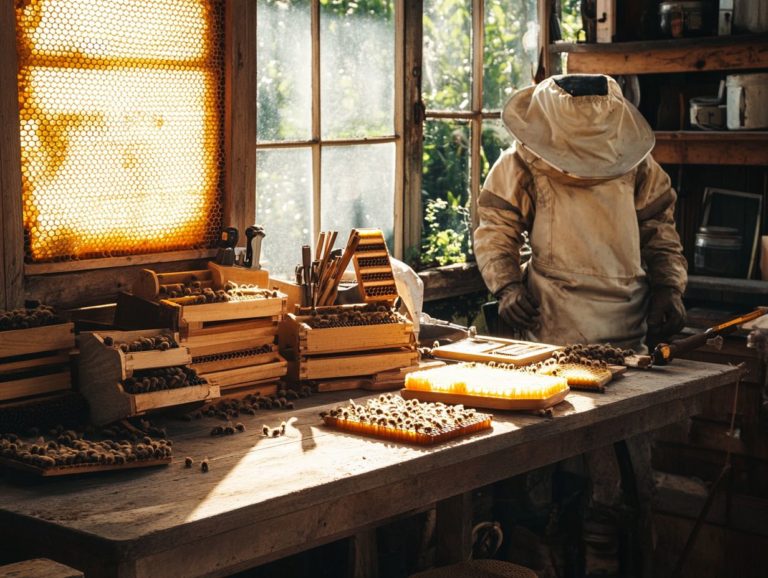Understanding How to Use a Honey Jar Label
When it comes to honey, a carefully designed jar label does more than simply catch the eye—it acts as an essential resource for consumers.
A well-crafted label identifies the type and origin of the honey, offers crucial nutritional information, and provides contact details. This thoughtful presentation can significantly enhance the experience of savoring this delightful treat.
This article delves into the importance of honey jar labels, outlines the essential information they should include, and shares tips for designing them effectively. You’ll also discover best practices for applying and storing these labels.
Get ready to elevate your honey packaging now!
Contents
- Key Takeaways:
- Why is a Honey Jar Label Important?
- What Information Should be Included on a Honey Jar Label?
- How to Design a Honey Jar Label?
- How to Apply a Honey Jar Label?
- 1. Clean the Jar
- 2. Remove Air Bubbles
- 3. Apply the Label Carefully
- How to Store Honey Jars with Labels?
- Frequently Asked Questions
- What is a honey jar label and why is it important to understand how to use it?
- What information should be included on a honey jar label?
- How can I ensure that I am reading and understanding a honey jar label correctly?
- Why is it important to properly store and handle honey jars?
- Can I reuse a honey jar label?
- Are there any regulations or guidelines for honey jar labels?
Key Takeaways:
- Include essential information on a honey jar label such as type of honey, origin, nutritional information, production and expiration dates, and contact information.
- Design a visually appealing label by considering the label size and shape, branding, legible fonts and colors, and eye-catching graphics.
- Properly apply and store honey jars with labels by carefully cleaning the jar, avoiding direct sunlight, and checking labels regularly for wear and tear.
Why is a Honey Jar Label Important?
A honey jar label is crucial for honey marketing, serving as both an identifier for the product and a key communication tool that conveys important information about quality, ingredients, and sustainability practices of the producers.
A beautifully crafted and thoughtfully designed label can greatly enhance how customers perceive the brand.
It also builds their trust in the product’s quality. When consumers easily recognize the packaging and its branding, it creates a stronger bond with the product and its origins.
What Information Should be Included on a Honey Jar Label?
When you design a honey jar label, it’s crucial to incorporate information that effectively conveys the product’s qualities while ensuring consumer safety.
Make sure key details—like the type of honey, ingredients, nutritional information, production date, expiration date, and your contact information—are clearly visible. This approach meets regulatory requirements and fosters transparency, giving your customers the power to make informed choices that align with their dietary preferences and needs.
1. Type of Honey
The type of honey on a jar label reveals a world of specific varieties, such as Rape Honey, Borage Honey, or Heather Honey, each boasting unique floral characteristics and taste profiles. By understanding these distinctions, you give the power to make informed choices tailored to your personal preferences and desired experiences.
Take Rape Honey, for instance. Its light color and mild, slightly tangy flavor make it a favorite for those who enjoy a gentle sweetness. On the other hand, if you’re in the mood for something more substantial, Heather Honey—with its richly intense and slightly earthy notes—may be just what you’re seeking.
Don’t overlook the health benefits, either. Varieties like these come packed with antioxidants and natural antibacterial properties, which help fight damage in your body and prevent infections. When you choose local and artisanal honey, sourced from bees pollinating native flora, you’re not just supporting sustainable practices; you’re also indulging in flavors that genuinely reflect the region’s biodiversity.
With a growing interest in gourmet food products, diving into different honey varieties can lead you on delightful culinary adventures that elevate your palate.
2. Origin of Honey
Understanding where honey comes from is essential for you as a consumer. It offers valuable insights into the practices of honey producers, both local and international. This knowledge also highlights the sustainability efforts within the beekeeping industry.
When you know the source of your honey, you’ll be amazed to discover the unique flavors shaped by the local plants and climate of various regions. This appreciation enhances your tasting experience and underscores the importance of sustaining bee populations, which are vital for pollinating many plants crucial to our ecosystem.
Clear labeling gives you the power to make informed choices. It enables you to support local honey producers who prioritize ecological balance and community engagement. By opting for locally sourced honey, you’re not just choosing a sweet treat; you’re actively contributing to sustainable agriculture and helping protect the delicate biodiversity that bees and other pollinators depend on to thrive.
3. Nutritional Information
The nutritional information on a honey jar label provides valuable insights into the health benefits and calories of honey, especially when distinguishing between raw honey and processed varieties. This information serves as a guide, helping you make healthier choices that align with your dietary preferences and wellness goals.
Understanding these details deepens your appreciation for various types of honey, such as wildflower, clover, or manuka. It also helps you identify the unique sugars present in each one. When you know the calories and recognize the antioxidants—substances that help protect your cells—in different honey types, you’ll be better equipped to incorporate this natural sweetener into your balanced diet.
Being aware of the health benefits associated with various honey varieties encourages informed decisions. This ultimately enhances your overall well-being and allows you to choose sweeteners that positively contribute to your nutritional intake.
4. Production Date
The production date on a honey jar label is essential for you as a consumer to evaluate the freshness and quality of the honey. It ensures you receive a product that meets your expectations for flavor and texture.
Freshness plays a key role in honey’s taste profile, and savvy brands recognize the importance of showcasing production dates. By highlighting product freshness, they cater to consumers like you who prioritize quality and flavor in their culinary choices. This enhances your brand loyalty and positions the brand as a leader in quality assurance, influencing purchasing decisions in a competitive market.
When you realize you’re selecting a fresher, higher-quality product, you’re more inclined to share your positive experiences with others. This further elevates the brand’s reputation.
5. Expiration Date
Including an expiration date or a “best before” date on your honey jar labels is crucial for consumer safety. It informs customers about the product’s shelf life and optimal usage period. This essential detail not only meets regulatory requirements but also shows your commitment to quality and consumer well-being.
Clear labeling is especially important for honey, known for its remarkable longevity. When customers can easily see the freshness of their purchase, they gain confidence in the quality and safety of what they’re buying. Brands that prioritize transparent communication foster loyalty and cultivate a positive reputation in the marketplace.
This respect for consumer needs can lead to increased sales and a dedicated customer base, ultimately benefiting both your brand and your clientele.
6. Contact Information
Including contact information on honey jar labels promotes transparency and ensures that you, as a customer, can easily reach out with inquiries or feedback.
This simple gesture enhances your overall experience with the brand and fosters a connection built on trust between you and the producers.
When you are empowered to engage directly with a business, it significantly strengthens your loyalty. Knowing that your voice matters makes a difference.
Open channels for communication not only facilitate the exchange of ideas but also offer invaluable insights that can lead to improved products and services.
By allowing you to ask questions or share your thoughts, the brand showcases its commitment to quality and accountability. This approach creates a community where you feel valued and appreciated, paving the way for long-lasting relationships that benefit everyone involved.
How to Design a Honey Jar Label?
To design an effective honey jar label, you’ll want to strike the perfect balance between creativity and strategy. Focus on eye-catching elements that not only grab consumer attention but also clearly convey essential product information.
The choice of label size and shape, along with good branding and design, plays a pivotal role in influencing purchasing decisions.
By incorporating vibrant colors and engaging graphics, you can elevate the product’s appeal, ensuring it stands out on the shelves and resonates with your target customers.
1. Choose a Label Size and Shape
Choosing the right label size and shape is essential for grabbing consumer attention while providing ample space for all necessary information without looking cluttered.
The label’s dimensions should beautifully complement the jar’s design and enhance your branding efforts effectively, while also meeting regulatory requirements.
The relationship of size and shape profoundly influences how consumers perceive your product’s quality and value. A larger label may suggest abundance, enticing buyers to associate it with desirable traits like premium quality or artisanal craftsmanship.
Consumers often prefer labels that indicate organic ingredients or raw honey, enhancing their purchasing decisions. Conversely, a uniquely shaped label can evoke a sense of novelty, helping your jar stand out on crowded shelves and leading to increased brand recognition.
It’s crucial for you to consider these elements during the way you create and arrange your product’s packaging, as the right label not only communicates vital details such as nutritional information and best before date but also fosters emotional connections that significantly impact purchasing decisions.
2. Consider the Branding and Aesthetics
Branding and aesthetics are crucial when designing a honey jar label; they help convey the essence of your product and create a genuine connection with consumers. The design elements you choose—logos, colors, and imagery—should reflect your brand’s values and the quality of the honey, resonating with your target market’s preferences and their awareness of local honey varieties like Welsh Honey and Kent Honey.
When consumers view your brand’s visual identity as cohesive and appealing, their trust in your product grows, fostering strong loyalty over time. Elements like typography, texture, and overall layout play a significant role in crafting a memorable aesthetic that can evoke emotions and leave a lasting impression.
For instance, a warm color palette can evoke feelings of comfort and nostalgia, positioning your honey as a truly wholesome choice that emphasizes sustainability and the artisanal nature of your product.
Effective branding not only sets your product apart in a crowded market but also reinforces the connection between the consumer’s identity and the values represented by your label. This synergy ultimately drives repeat purchases and enhances the overall customer experience, especially when brands highlight their certifications, such as organic certification.
3. Use Legible Fonts and Colors
Using legible fonts and appropriate colors is vital in your honey jar label design. This ensures that all essential information is easily readable and accessible to consumers. Your choice of font style and color scheme should not only complement the overall aesthetics but also draw attention to key product details like ingredients and nutritional information.
Visual organization is crucial for guiding the consumer’s eye toward important information. This makes it easier for them to make informed decisions. Using different font sizes and weights effectively enhances legibility, increasing the likelihood of engagement. This can ultimately influence consumer behavior in a competitive market.
Dark, bold fonts can highlight product names, while softer hues can convey flavor or brand essence. This smart choice creates a strong bond with buyers and reinforces your brand identity. It ensures that your product stands out on the shelf in a crowded market through eye-catching designs.
4. Include Eye-catching Graphics
Incorporating eye-catching graphics into your honey jar label can elevate its visual appeal. This draws consumers’ attention and distinguishes your product from competitors on the shelf. By using vibrant images, patterns, or illustrations, you can create an emotional connection and narrate a story about the honey’s origin, its unique qualities, and the bees that help produce this treasured product.
For instance, graphics showcasing bees in their natural habitat or stunning floral motifs can evoke feelings of nature and purity. This allows consumers to envision the care and craftsmanship involved in the honey-making process. An earthy color palette can resonate with those in search of organic or artisanal products. Meanwhile, playful character designs might charm children and families alike, promoting awareness of local honey farms.
Including local landmarks or symbols can nurture a sense of community and pride. This transforms your product from mere food into a cherished part of a lifestyle. When these elements are thoughtfully combined, they weave a memorable visual narrative. This encourages consumers to choose your jar of honey over all the others on the shelf, especially when highlighting local flavors and the story of honey producers.
5. Make Sure Information is Clear and Concise
Ensuring that the information on a honey jar label is clear and concise is essential for effective communication with consumers. Overwhelming or cluttered labels can drive potential buyers away. Streamlined information builds trust and inspires informed purchasing decisions, especially concerning health-related nutritional information.
To achieve this clarity, effective use of space is crucial. Ample white space allows the eye to focus on essential details without distraction. Prioritizing key information—such as the product’s origin, ingredients, and health benefits—should take precedence over decorative elements. By emphasizing these attributes, you can convey your message more efficiently and ensure compliance with FDA regulations.
Utilizing bold fonts and contrasting colors can further enhance readability. This ensures that vital details are impossible to overlook, especially when highlighting contact information for local businesses. Successful packaging design strikes a balance between aesthetics and substance, ultimately leading to better consumer engagement and satisfaction.
How to Apply a Honey Jar Label?
Applying a honey jar label correctly is crucial for ensuring it adheres flawlessly and showcases your product beautifully on the shelf. This is particularly important given the unique characteristics of different honey varieties. Follow these meticulous steps to apply your label:
- Clean the glass jar’s surface to perfection;
- Eliminate any air bubbles that could jeopardize the label’s pristine appearance;
- Apply the label with precision to maintain both alignment and visual appeal.
1. Clean the Jar
The first step in applying a honey jar label is to ensure the jar is impeccably clean. Dust, grease, or moisture can prevent the label from sticking well and compromise its appearance.
This preparation phase not only elevates the visual appeal of your packaging but also ensures the label stays intact throughout its shelf life. Wash the jars with warm, soapy water, followed by a thorough rinse with clean, lukewarm water to eliminate any soap residues.
Make sure to dry the jars completely with a lint-free cloth or allow them to air dry. This will prevent unsightly water spots and streaks that could affect the labeling process and the honey’s quality.
By sticking to these practices, you can significantly enhance the durability and aesthetic quality of your final product, leaving a remarkable impression on potential customers.
2. Remove Air Bubbles
Don’t miss this step—eliminate air bubbles for a flawless finish! After you clean the jar, it’s crucial to get rid of any air bubbles that may form during the application process. These bubbles can mar the appearance of your label and compromise its adherence.
To remove air bubbles, use a smoothing tool or a simple card, gently pressing from the center towards the edges. This meticulous approach helps flatten the label and minimizes the risk of damage, ensuring an attractive presentation.
Work slowly and monitor the material, making sure no new bubbles appear while adjusting the label. Patience is key in this step, as it ultimately elevates the product’s aesthetics and integrity.
3. Apply the Label Carefully
When you apply the label to the honey jar, take your time to ensure proper alignment and adherence. Misaligned labels can undermine the overall presentation and negatively affect how consumers perceive the quality of your product.
To achieve this, prepare the surface of the jar by ensuring it’s clean and free from any moisture or dust. Tools like a labeling applicator can help you apply labels smoothly and precisely, reinforcing the importance of a clean workspace.
Pay attention to the label’s placement—making sure it’s straight and centered. This enhances aesthetics and contributes to a professional image. Consumers often equate well-executed labels with higher quality, which can influence their purchasing decisions.
How to Store Honey Jars with Labels?
Storing honey jars with labels correctly is crucial for maintaining quality and freshness, as well as preserving the integrity of the labels.
To ensure optimal storage, keep your jars in a cool, dry place, away from direct sunlight, and avoid refrigeration. These conditions can adversely impact both the honey and its labeling, so be mindful of how you store them to maintain quality.
Follow these steps, and watch your honey jars impress customers and boost your sales!
1. Keep Jars in a Cool, Dry Place
Keeping your honey jars in a cool, dry place is essential for preserving their quality and freshness. When exposed to heat and moisture, honey can spoil and lose its delightful flavor and nutritional benefits.
To maintain optimal storage conditions, aim to keep your honey at temperatures between 50°F and 70°F. This range helps prevent unwanted crystallization, which is when honey turns into sugar crystals, changing its texture.
Minimizing humidity is crucial. High moisture levels can lead to fermentation, ruining the taste and posing safety concerns. Using air-tight containers is key to preventing the absorption of surrounding odors, allowing honey to retain its natural aroma and flavor profile for a longer period.
Follow these storage tips to enjoy the amazing taste of honey every time!
2. Avoid Direct Sunlight
Avoiding direct sunlight is essential when storing your honey jars. Exposure to UV rays can diminish honey’s color, flavor, and nutritional value and deteriorate the label itself. This keeps your honey and its label looking great!
To further safeguard your honey from light, consider using opaque storage containers. These effectively shield the contents from even indirect sunlight. Opting for amber or dark glass jars not only elevates the aesthetic appeal but also preserves all the natural properties of your honey.
Storing honey in cool, dark places can dramatically extend its shelf life, ensuring every jar delivers the rich taste and health benefits you expect.
3. Do Not Refrigerate
Refrigerating honey isn’t advisable, as the cold can lead to crystallization, making it less appealing. Storing honey outside the refrigerator allows it to maintain its natural consistency.
The ideal storage temperature for honey hovers around room temperature, specifically between 60°F to 80°F (15°C to 27°C). Placing honey in a cool, dark spot—like a pantry or cupboard—preserves its delightful viscosity and rich flavor.
It’s vital to avoid moisture and direct sunlight, as these can compromise honey’s quality over time. Being aware of these storage practices is essential for enjoying this exquisite natural sweetener.
4. Check Labels Regularly for Wear and Tear
Regularly inspecting honey jar labels for wear and tear is essential for maintaining a polished appearance and ensuring that important info stays clear and easy to read. This practice reinforces your brand’s quality and cultivates consumer trust.
In an industry where consumer perception hinges heavily on packaging, overlooking label maintenance can lead to misconceptions about quality and safety. Any signs of damage may prompt potential customers to question your brand’s commitment to excellence.
By proactively monitoring your packaging, you uphold your brand integrity and enhance the overall shopping experience. A pristine appearance communicates reliability, reassuring consumers that they are making a wise choice when selecting your honey.
Frequently Asked Questions
What is a honey jar label and why is it important to understand how to use it?
A honey jar label is a sticker or tag that contains important information about the honey inside the jar. It is important to understand how to use it because it provides details about the honey, such as its source, production date, and any special instructions or warnings. Knowing how to read the label helps you choose the best honey for your needs.
What information should be included on a honey jar label?
A honey jar label should include the type of honey and its source. It should also list the production date, important notes, and the producer’s contact information.
Nutritional information, certifications, and special features may also be included.
How can I ensure that I am reading and understanding a honey jar label correctly?
Familiarize yourself with common terms like “raw” and “organic.” Carefully read the entire label and note any specific instructions or warnings.
If you have questions, don’t hesitate to reach out to the producer.
Why is it important to properly store and handle honey jars?
Honey is delicate and can easily be affected by temperature, light, and moisture. Proper storage keeps the honey’s quality and taste intact while preventing contamination.
Can I reuse a honey jar label?
No, reusing a honey jar label is not recommended. Information can change with each batch of honey, and reusing a label may lead to confusion.
Are there any regulations or guidelines for honey jar labels?
Yes, government agencies like the FDA set regulations for honey jar labels. These guidelines ensure that the information is accurate and not misleading.

